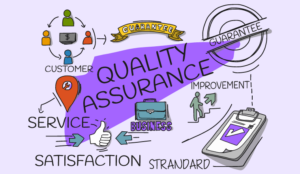The way that contact centres operate is rapidly changing. The adoption of remote working has challenged the traditional customer service operating model, particularly in regulated industries.
And as we emerge from a global pandemic with the risks of UK economic recession, it has never been more important to balance the needs of customers – treating them fairly – against commercial performance outcomes.
Contact centres are highly metricized environments that provide a plethora of reports, QA checks and data. However, what is too often missing is the ability for agents and team leaders to engage with that information and take ownership of the results.
The hypothesis behind this series of articles is that every operation has the ability – through its frontline teams – to leverage its own value, which in turn uplifts performance outcomes.
Define the Problem to Be Solved
Start by considering your current practices in the current economic content, as I would expect every contact centre to already have processes and procedures around performance management, coaching and QA.
However, be aware of the truism that there’s no such thing as a bad KPI metric, just bad management of the metrics. If you recognize a delivery problem in your customer-facing and admin operations, then you need to fix it.
I suggest breaking the problem down into manageable chunks around the levers of performance management, coaching and QA.
Performance Management
The Context – The risk of a downturn means a practical reality where operations need to deliver ‘more with less’ – higher revenues, with less capacity, at optimal compliance.
The Challenge – Too often operational staff are drowning in data and lack the insight, tools and support to manage their personal performance.
Coaching
The Context – Contact centre operations have always relied on people management, and the shift to remote working has made this even more important.
The Challenge – Many of the social norms of working together in an office have been taken away, including the ability of a team leader to physically observe an agent in action.
Quality Assessments
The Context – The need for regulated industries – in particular through their Quality Assurance model – to improve QA processes, reporting, insights and QA Team efficiency.
The Challenge – Too many manual interventions by the QA team to deliver their key functions of targeted risk management, assessment completion, feedback & challenge process, ‘check the checker’ validations and compliance reporting.
How to Create the Case for Performance Change – a Guide for Your Executive Sponsor
When talking to your sponsors, there are five steps that you need to consider around the ‘case for change’ for investing in performance improvement:
Step 1: Define the Opportunity
As a consultant, I would fully expect that your operation will already have predefined targets to meet that are baked into the business plan for the year – absolute numbers for revenue, contact handling productivity, process compliance, etc.
The operational focus on delivering these outcomes is to ‘control the controllables’ – that means having an optimal spread of performance across your agent population.
If you break down your workforce into four quartiles, then you should target improved performance levels across the bottom two quartiles (50% of your staff).
Use historic KPI data to size the prize in terms of what this could mean in terms of a performance benefit uplift, by, for example, calculating the difference of Q4 performers delivering at Q3 levels and then Q3 performers delivering at Q2.
Step 2: Understand How This Uplift Will Be Delivered
You need to consider if you have the right tools to support this type of operational transformation, in order to track the impact of every coaching session, every quality assessment that you need to take action on, and every piece of recognition provided.
The requirements include:
- Intuitive dashboards, where relevant individual performance KPIs are provided
- Integrated coaching tools that record coaching sessions and quality scores so that the impact of team leader actions (the inputs) can be linked to changes in agent behaviour (the outcome)
- A QA tool for end-to-end automation of assessments, tracking and reporting
This is so you can codify how you are going to do things better, using data to identify the best performers in terms of their behaviours, allowing you to replicate this through nudges and process workflow so that the improved performance is cascaded across the operation.
Step 3: Be Clear on What You Need to Be Successful
We all know that the team leader has the most important role in delivering operational performance – as a role model coach and developer of staff – but sometimes the talent pool can be variable. You need to be able to help your weaker leaders to prioritize the key activities by creating a workflow around the development activities that they need to deliver
It’s likely that you will already have an assortment of tools – call recording systems, quality forms, KPI dashboards, etc. You need to determine if what you have is fit for purpose, in particular how to reduce the manual handling time-wasting activities (report production, QA and coaching administration etc.) so that you focus more effort on the things that matter,
At this point, you need to be clear on whether you are going to use current technology, or upgrade it so that it becomes a catalyst for change. The choice is yours.
Step 4: Define the Focus Areas for Improvement
In terms of implementation, you might start with solving a compliance issue to mitigate a high-priority regulatory risk, but you can just as easily flip a switch and focus on continuous improvement that drives operational efficiency (capacity release) and/or operational effectiveness (higher quality interactions) that in turn lead to higher customer scores and lower churn rates.
You need to keep your business case configurable – wherever you need to shine a light – so that it becomes self-sustaining as team engagement levels rise and agent behaviours change.
You need to keep your business case configurable – wherever you need to shine a light – so that it becomes self-sustaining as team engagement levels rise and agent behaviours change.
Step 5: Execute the Change
In terms of performance management, consider using a performance league as an objective quantification of the spread of performance across the operation against its KPI targets.
With coaching, consider using gamification to keep remote staff engaged – from getting a quick ‘Like’ from your team leader, achieving a new Personal Best, to being the best improver in your peer group or team.
And with QA, consider how to standardize and automate where possible processes for flagging agent risk levels, completing QA Team workflow, and compliance reporting.
In the future you might even want to consider 360-degree employee feedback and to monitor well-being – as a heat map on how the operation is feeling.
Potential Benefits
The outcome is an integrated approach with everything you need to create an effective remotely managed contact centre workforce in one place, managed through three separate lenses:
- Performance – through team and agent KPIs, achievements and recognition
- Coaching – through tracking events in coaching records, to spotting behaviour change
- Quality – through applying a consistent approach to the application of quality, workflow management and risk assessment
To give you a rough order of magnitude (ROM) of benefits, then wearing my consultant hat, I would expect that it should be possible to deliver a 5-10% uplift in results by transforming the way individuals and self-managing teams use information to drive continuous improvement.
That could translate into OPEX savings (doing more with less), better customer outcomes (higher NPS scores) or lower compliance risk (reducing the threat of fines). Any of these levers should be sufficient to justify an investment in technology tools that you might choose to make.

Paul Weald
From a people perspective, where all team leaders provide guidance, encouragement and mentoring to get every team member to take ownership of their personal performance, then the mantra becomes what gets measured, recognized, rewarded and celebrated…. gets done.
And in terms of QA effectiveness, these benefits arise from higher QA pass rates, 100% agent assessment completion rates, plus a more efficient check-the-checker process.
Next Steps
The next articles in this series will look into these factors in more detail– giving operational managers a checklist of factors to consider.
Written by: Paul Weald, Contact Centre Innovator
For more information about performance in the contact centre, read these articles next:
- Contact Centre Benchmarking vs. Balanced Scorecard: Which Is Best?
- How to Improve Call Centre Performance
- 5 Important Call Centre Metrics to Improve Agent Performance
Author: Paul Weald
Published On: 23rd Mar 2022 - Last modified: 9th Nov 2023
Read more about - Call Centre Management, Agent Performance, Coaching, Editor's Picks, Paul Weald, Performance Management, Quality



















